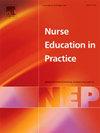护生工作能力的检测:工作需求、控制和社会支持的作用
IF 3.3
3区 医学
Q1 NURSING
引用次数: 0
摘要
目的探讨影响护生工作能力的关键因素,重点研究工作需求和社会支持的作用。护士的高流动率导致了全球护士短缺,在学习期间,人们往往会萌生离开护士行业的念头。工作能力是一个公认的职业流动意向的预测因子。设计在捷克护理专业学生中进行了一项全国性的横断面调查研究,采用在线自我管理问卷。方法采用社会人口学和记忆特征、健康感知、工作挑战经历、工作需求、控制和社会支持(JDCS)结构和工作能力指数(WAI)进行问卷调查。结果骨骼肌疼痛普遍存在:81.3% %报告腰痛,68.8% %报告颈痛,52.1% %报告肩痛。WAI评分中位数为39(范围:20-49)。WAI评分与自我感知健康(rho = 0.531)和感知疲惫(rho = - 0.542)有中度相关。腰痛(β = - 1.67)、上背痛(β = - 2.56)、肩痛(β = - 2.72)和颈痛(β = - 2.81)的学生报告较低的WAI。工作场所欺凌(β = - 2.66)和歧视(β = - 2.14)进一步降低了WAI。工作需求(β = - 0.70)降低了WAI,工作控制(β = 0.66)和社会支持(β = 0.67)提高了WAI。结论自我感知健康和社会支持对工作能力有正向影响,而感知疲劳、肌肉骨骼疼痛和职场欺凌和歧视对工作能力有正向影响。创造支持性环境和应对健康挑战可提高年轻护理人员的留任率和福祉。本文章由计算机程序翻译,如有差异,请以英文原文为准。
Examining work ability in nursing students: The role of job demand, control, and social support
Objective
This study aimed to identify key factors affecting nursing students' work ability, focusing on the roles of job demands and social support.
Background
High nurse turnover contributes to a global shortage, with intentions to leave the profession often forming during study years. Work ability is a well-established predictor of career mobility intentions.
Design
A nationwide cross-sectional survey-based study was conducted among Czech nursing students using an online self-administered questionnaire.
Methods
The questionnaire covered sociodemographic and anamnestic characteristics, health perceptions, workplace challenging experiences, job demand, control, and social support (JDCS) constructs, and the Work Ability Index (WAI).
Results
Musculoskeletal pain was prevalent: 81.3 % reported lower back pain, 68.8 % neck pain, and 52.1 % shoulder pain. The median WAI score was 39 (Range: 20–49). WAI score was moderately correlated with self-perceived health (rho = 0.531) and perceived exhaustion (rho = −0.542). Students with lower back pain (β = −1.67), upper back pain (β = −2.56), shoulder pain (β = −2.72), and neck pain (β = −2.81) reported lower WAI. Workplace bullying (β = −2.66) and discrimination (β = −2.14) further reduced WAI. While job demand (β = −0.70) lowered WAI, job control (β = 0.66) and social support (β = 0.67) improved it.
Conclusions
Self-perceived health and social support positively influence work ability, while perceived exhaustion, musculoskeletal pain, and workplace bullying and discrimination reduce it. Creating supportive environments and addressing health challenges may enhance retention and well-being in the young nursing workforce.
求助全文
通过发布文献求助,成功后即可免费获取论文全文。
去求助
来源期刊

Nurse Education in Practice
NURSING-
CiteScore
5.40
自引率
9.40%
发文量
180
审稿时长
51 days
期刊介绍:
Nurse Education in Practice enables lecturers and practitioners to both share and disseminate evidence that demonstrates the actual practice of education as it is experienced in the realities of their respective work environments. It is supportive of new authors and will be at the forefront in publishing individual and collaborative papers that demonstrate the link between education and practice.
 求助内容:
求助内容: 应助结果提醒方式:
应助结果提醒方式:


